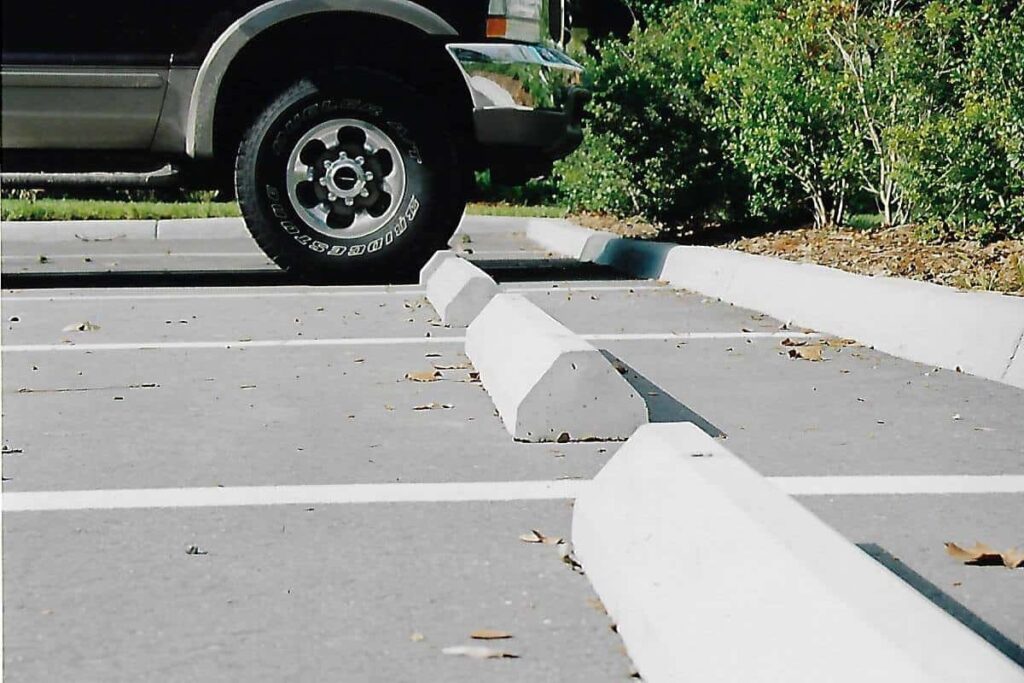How to Choose the Best Parking Bumpers for Commercial Properties
When managing a commercial property, ensuring that your parking lot is well-organized, safe, and functional is crucial. One often-overlooked aspect of parking lot management is the selection of the right parking bumpers. Also known as wheel stops, these devices play a vital role in controlling vehicle movement within parking spaces, protecting infrastructure, and enhancing the safety of pedestrians. In this guide, we’ll dive into how to choose the best parking bumpers for your commercial property.
If you’re located in Louisville, Kentucky, or nearby, Commonwealth Paving offers expert advice and top-quality services to help you select the perfect parking bumpers. You can reach us at +1 502 459 7283, or visit us at 136 Outerloop, Louisville, Kentucky 40214.
1. Why Parking Bumpers are Essential for Commercial Properties
Before choosing the right parking bumpers, it’s important to understand why they are an integral part of a well-managed parking lot. Properly placed parking bumpers:
- Enhance Safety: They help prevent vehicles from overrunning parking spaces and damaging buildings, sidewalks, or other vehicles.
- Protect Infrastructure: By controlling vehicle movement, they prevent costly damages to curbs, landscaping, walls, and signage.
- Improve Traffic Flow: When strategically placed, they help maintain an organized flow of traffic within the parking lot.
- Ensure Compliance: For businesses, complying with local zoning and safety regulations often requires installing parking bumpers in specific areas.
Given their role, selecting the right parking bumpers can make a big difference in the long-term functionality and safety of your parking lot.
2. Types of Parking Bumpers
Parking bumpers come in various materials, each with its unique benefits and drawbacks. Understanding these differences can help you choose the best option for your property.
Concrete Parking Bumpers
Concrete parking bumpers are the traditional choice for many commercial properties. They are durable, heavy, and offer excellent resistance to impact.
Pros:
- Durability: Concrete bumpers are extremely robust and can withstand significant wear and tear.
- Affordability: They are often more cost-effective than other materials.
- High Visibility: When painted, they offer clear visual guidance for drivers.
Cons:
- Weight: Due to their heaviness, they can be difficult and costly to install and move.
- Susceptibility to Damage: Concrete can crack over time, especially in areas with extreme weather changes.
- Maintenance: Paint on concrete bumpers may fade and require regular touch-ups.

Rubber Parking Bumpers
Rubber parking bumpers are increasingly popular for their flexibility and environmental benefits. They are typically made from recycled rubber and are lighter than concrete.
Pros:
- Flexibility: Rubber bumpers can absorb impact better than concrete, reducing the risk of vehicle damage.
- Ease of Installation: They are lightweight and easy to install or relocate.
- Environmentally Friendly: Many rubber bumpers are made from recycled materials, making them an eco-friendly choice.
- Weather Resistance: Rubber is less prone to cracking in extreme temperatures.
Cons:
- Cost: They are often more expensive upfront than concrete bumpers.
- Limited Durability: While they are flexible, rubber bumpers may wear out faster under heavy traffic.
Plastic Parking Bumpers
Plastic parking bumpers are lightweight and are often made from recycled plastic. They come in various colors and are ideal for properties seeking a versatile and cost-effective solution.
Pros:
- Lightweight: Plastic bumpers are easy to handle, transport, and install.
- Variety of Colors: They are available in a wide range of colors without the need for painting, which ensures long-lasting visibility.
- Durable in Harsh Conditions: They are resistant to weather-related damage, including UV rays, moisture, and extreme temperatures.
Cons:
- Stability: Due to their light weight, plastic bumpers may shift if not securely anchored.
- Lower Impact Resistance: They may not be as durable under heavy use or in high-traffic areas.
Steel Parking Bumpers
Steel parking bumpers are less common but are used in heavy-duty environments where strength and durability are key considerations.
Pros:
- Strength: Steel bumpers can handle heavy impacts and are ideal for industrial settings.
- Durability: They are resistant to chipping, cracking, and other forms of wear and tear.
Cons:
- Cost: Steel bumpers tend to be the most expensive option.
- Corrosion Risk: Without proper treatment, steel bumpers can rust over time, particularly in wet climates.
3. Key Considerations for Choosing the Right Parking Bumpers
Once you’ve determined which material is best suited for your commercial property, there are several other factors to consider before making your purchase.
Size and Dimensions
Parking bumpers come in various sizes, so it’s important to choose the right dimensions for your specific parking lot layout. Standard bumpers are typically 6 feet long and 4 to 6 inches high, but larger or smaller options are available depending on the space. For example, compact spaces may require shorter bumpers, while larger lots with high vehicle turnover might need more substantial options.
Placement and Spacing
Proper placement is crucial for ensuring that parking bumpers effectively prevent vehicles from overrunning parking spaces while maintaining an organized flow of traffic. Typically, bumpers are placed 3 feet from the end of a parking space, but this may vary depending on local regulations and the type of vehicles using the lot.
Installation Requirements
Different materials have different installation processes. Concrete bumpers require more labor and specialized equipment, while rubber and plastic bumpers can be installed quickly with basic tools. It’s important to choose a material that aligns with your budget and installation needs.
Visibility and Reflectivity
For optimal safety, parking bumpers should be easily visible to drivers. High-contrast colors like yellow, white, or blue are commonly used to ensure visibility during both day and night. Additionally, some bumpers come with reflective tape or embedded lights to enhance nighttime visibility.
Maintenance and Longevity
Consider the long-term maintenance requirements of each type of parking bumper. Concrete bumpers may require periodic repainting, while rubber and plastic bumpers are generally low-maintenance. Weigh the upfront cost against potential long-term maintenance needs when making your decision.
Compliance with Local Regulations
Before installing parking bumpers, ensure that you’re in compliance with local zoning laws and accessibility standards, especially those related to ADA (Americans with Disabilities Act) requirements. Your contractor should be familiar with these regulations and be able to guide you through the process.
4. Why Professional Installation is Important
While it may be tempting to handle the installation yourself, professional installation ensures that your parking bumpers are correctly placed, securely anchored, and compliant with all relevant regulations. At Commonwealth Paving, we provide expert installation services that guarantee durability and safety for your commercial property.
5. The Benefits of Partnering with Commonwealth Paving
When it comes to choosing and installing parking bumpers, partnering with an experienced contractor like Commonwealth Paving offers several advantages:
- Expert Guidance: We help you choose the right material, size, and placement for your specific property needs.
- Professional Installation: Our team handles all aspects of the installation process, ensuring that your parking bumpers are securely in place and compliant with local regulations.
- High-Quality Materials: We use only the best materials to ensure that your parking bumpers are durable, weather-resistant, and long-lasting.
- Customer Service: We prioritize customer satisfaction and are committed to delivering top-tier service from start to finish.

For more information, or to discuss your parking bumper needs, contact us at +1 502 459 7283, or visit us at 136 Outerloop, Louisville, Kentucky 40214.
Choosing the right parking bumpers for your commercial property is a critical step in maintaining a safe, organized, and visually appealing parking lot. By considering factors like material, size, visibility, and installation requirements, you can select the best option to meet your property’s needs. At Commonwealth Paving, we’re here to help you make the best decision and ensure a hassle-free installation process. Reach out to us today to get started on improving the safety and functionality of your parking lot.
Everything You Need to Know About Parking Bumpers: Types, Benefits, and Installation
Managing a parking lot involves several key considerations to ensure safety, efficiency, and a positive experience for users. One of the most crucial components of a well-organized parking lot is the strategic use of parking bumpers. These simple yet effective tools help maintain order, prevent accidents, and protect your property from damage. In this comprehensive guide, we’ll explore the different types of parking bumpers, their benefits, and essential installation tips for commercial and residential properties.
If you’re looking for expert advice on selecting and installing parking bumpers for your property in Louisville, Kentucky, contact Commonwealth Paving at +1 502 459 7283, or visit us at 136 Outerloop, Louisville, Kentucky 40214.
1. What Are Parking Bumpers?
Parking bumpers, also known as wheel stops or curb stops, are raised barriers placed at the end of parking spaces to prevent vehicles from overextending and hitting sidewalks, curbs, walls, or other vehicles. They serve as a guide to ensure that drivers park within designated areas, reducing the risk of property damage and improving overall safety in parking lots.
Parking bumpers are commonly used in commercial, industrial, and residential parking lots, as well as in garages, schools, and other public spaces.
2. Types of Parking Bumpers
Choosing the right parking bumpers depends on factors such as the type of vehicles using the lot, weather conditions, budget, and aesthetic preferences. Here are the most common types of parking bumpers:
Concrete Parking Bumpers
Concrete parking bumpers are the most traditional and widely used option. Known for their durability and strength, they are often found in large parking lots, commercial properties, and industrial areas.
Pros:
- Durability: Concrete bumpers can withstand heavy vehicles and harsh conditions.
- Cost-Effective: They are generally more affordable than other options.
- High Stability: Due to their weight, they are less likely to move or shift out of place.
Cons:
- Heavy: Their weight makes them difficult to install and relocate.
- Cracking: Concrete is susceptible to cracking, especially in regions with extreme temperature fluctuations.
- Maintenance: Concrete bumpers require regular painting and repair as they can fade or chip over time.
Rubber Parking Bumpers
Rubber parking bumpers have gained popularity due to their flexibility, ease of installation, and environmental benefits. They are typically made from recycled rubber and are a lightweight, versatile solution.
Pros:
- Impact Absorption: Rubber bumpers are more forgiving and reduce the risk of vehicle damage.
- Eco-Friendly: Many rubber bumpers are made from recycled materials, making them an environmentally conscious choice.
- Easy Installation: They are lightweight and easy to install or move if needed.
Cons:
- Higher Initial Cost: Rubber bumpers may be more expensive upfront compared to concrete.
- Less Stability: They may shift if not properly anchored, especially in high-traffic areas.
Plastic Parking Bumpers
Plastic parking bumpers offer a lightweight and customizable solution for properties of all sizes. They are available in various colors and are often made from recycled plastic.
Pros:
- Variety of Colors: Plastic bumpers come in multiple colors that don’t require painting, offering long-lasting visibility.
- Weather Resistant: Plastic is resistant to moisture, UV rays, and temperature changes, making it suitable for all climates.
- Lightweight and Portable: Plastic bumpers are easy to install, remove, and reposition.
Cons:
- Durability: They may not be as long-lasting as concrete or rubber bumpers in high-traffic environments.
- Stability Issues: Like rubber bumpers, plastic options can move if not properly anchored.

Steel Parking Bumpers
Steel parking bumpers are typically used in heavy-duty or industrial settings where strength and durability are key.
Pros:
- High Durability: Steel bumpers can withstand significant impact and last longer than other materials.
- Strong and Sturdy: They are ideal for areas with heavy vehicle traffic or industrial vehicles.
Cons:
- Corrosion Risk: Steel bumpers can rust over time if not properly treated or maintained.
- Higher Cost: Steel is often the most expensive option among parking bumpers.
- Potential for Vehicle Damage: Their rigidity increases the risk of vehicle damage in the event of an impact.
3. Benefits of Installing Parking Bumpers
Installing parking bumpers offers numerous advantages for commercial properties, residential complexes, and public spaces. Some of the key benefits include:
Improved Safety
One of the primary purposes of parking bumpers is to enhance safety by preventing vehicles from overrunning parking spaces. This reduces the risk of accidents, property damage, and injuries to pedestrians.
Protection for Property and Infrastructure
Parking bumpers act as a buffer to protect buildings, sidewalks, landscaping, and other infrastructure from vehicle impact. They are especially useful in tight parking lots where space is limited.
Organized Parking and Traffic Flow
Strategically placed parking bumpers help maintain order within the parking lot by guiding drivers to park within designated spaces. This results in a more organized traffic flow and maximizes the efficient use of available space.
Cost-Effective Damage Prevention
By installing parking bumpers, property owners can avoid costly repairs to curbs, walls, and other structures. The investment in parking bumpers can lead to significant long-term savings by reducing the likelihood of vehicle and property damage.
Compliance with Local Regulations
In many areas, local zoning laws and safety regulations require the installation of parking bumpers to meet specific standards. Installing the appropriate bumpers ensures compliance with these rules, avoiding potential fines or legal issues.
4. Key Considerations When Choosing Parking Bumpers
Selecting the right parking bumpers involves more than just picking a material. Here are several factors to keep in mind:
Type of Vehicles
Consider the types of vehicles that will frequent your parking lot. For instance, heavy trucks and commercial vehicles may require more durable materials like concrete or steel, while lighter vehicles may be better suited to rubber or plastic bumpers.
Weather Conditions
If your area experiences harsh weather conditions, you’ll need bumpers that can withstand temperature fluctuations, moisture, and UV exposure. Rubber and plastic bumpers tend to fare better in extreme weather, while concrete may crack under these conditions.
Aesthetic Appeal
Parking bumpers are available in various colors and designs. Depending on your property’s branding or aesthetic preferences, you may want bumpers that blend in or stand out for enhanced visibility.
Budget
While concrete bumpers are generally more affordable, they may require more maintenance over time. Rubber and plastic bumpers come with a higher initial cost but can be more cost-effective in the long run due to lower maintenance needs.
Installation Requirements
Different bumper materials have different installation processes. Concrete bumpers are heavy and often require professional installation with specialized equipment, while rubber and plastic bumpers can be installed with basic tools.
Compliance
Ensure that your parking bumpers meet local zoning laws, safety regulations, and accessibility requirements, especially for ADA (Americans with Disabilities Act) compliance.
5. Installation Tips for Parking Bumpers
Proper installation is crucial for the effectiveness and longevity of parking bumpers. Here are some best practices:
Prepare the Surface
Before installation, ensure that the parking lot surface is clean, level, and free of debris. An uneven surface can lead to improper placement and reduce the effectiveness of the bumpers.
Use the Right Anchors
Depending on the bumper material, use appropriate anchors such as rebar, spikes, or bolts. For concrete surfaces, drilling holes and using heavy-duty anchors is often necessary to secure the bumpers.
Measure and Mark Placement
Measure and mark the exact placement of each parking bumper to ensure uniformity and alignment. The typical distance from the end of a parking space is around 3 feet, but this may vary depending on local regulations and vehicle size.
Ensure Proper Spacing
Leave adequate space between bumpers to accommodate different vehicle sizes and ensure smooth traffic flow. Proper spacing helps avoid congestion and improves the overall usability of the parking lot.
Regular Maintenance
Even the most durable bumpers require periodic maintenance. Regularly check for wear and tear, such as cracks, fading paint, or loose anchors. Prompt repairs or replacements can extend the life of your parking bumpers and maintain their effectiveness.
6. Why Choose Commonwealth Paving for Your Parking Bumper Needs
At Commonwealth Paving, we specialize in providing high-quality parking bumpers and professional installation services for commercial properties. Whether you need guidance on selecting the best material or expert installation, we’re here to help. Our team ensures that your parking bumpers are installed correctly, compliant with all regulations, and built to last.
Contact Us Today
For more information on parking bumpers or to schedule a consultation, contact us at +1 502 459 7283, or visit us at 136 Outerloop, Louisville, Kentucky 40214. We look forward to helping you enhance the safety, efficiency, and organization of your parking lot.
Selecting and installing the right parking bumpers is an important aspect of maintaining a well-organized and safe parking lot. By considering factors like material, vehicle type, and local regulations, you can make an informed decision that benefits both your property and its users. Whether you opt for concrete, rubber, plastic, or steel bumpers, investing in quality products and professional installation ensures long-term performance and reliability. Trust Commonwealth Paving for all your parking bumper needs and enjoy the peace of mind that comes with a well-managed parking lot.
Address
Commonwealth Paving, 136 Outerloop, Louisville, Kentucky 40214
Phone: 502-459-7283, Fax: 502-456-2678
Opening Hours
| Monday | 9:00 AM – 5:00 PM |
| Tuesday | 9:00 AM – 5:00 PM |
| Wednesday | 9:00 AM – 5:00 PM |
| Thursday | 9:00 AM – 5:00 PM |
| Friday | 9:00 AM – 5:00 PM |
| Saturday | Closed |
| Sunday | Closed |






